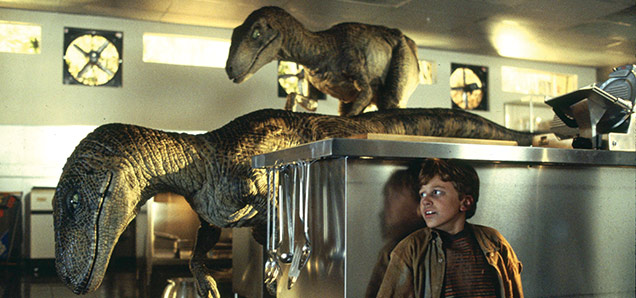Reel Life: Practicing practicality
 CREDIT: UNIVERSAL PICTURES
CREDIT: UNIVERSAL PICTURESJurassic Park's iconic velociraptor scene wasn't made with CGI. Scenes like this were created with costumes, puppets and animatronics.
Surprising use of model and special effects
Despite the loudest complaints from movie buffs and cinemagoers, CGI is king in special effects. Computers can – with enough time, money and pure, raw processing power – create the impossible. But some filmmakers beg to differ or at least lack access to the above criteria for creating convincing computer- based effects for a serious film. This is where old-fashioned practical effects come into play, be it miniatures, small or large-scale – biggatures as Peter Jackson calls them. Some amazing-looking films that have largely forgone the use of computer-generated imagery to realize imaginations include:
Jurassic Park
Jurassic Park is often cited as a film that still holds up visually despite having CGI effects over 20 years old. That’s because a small portion of the film actually uses computer-based effects – and those sequences noticeably stick out compared to the rest of the film. Jurassic Park didn’t quite kill the use of practical effects. Examples include the infamous velociraptors- in-the-kitchen scene, a significant chunk of the terrifying T-Rex’s rainy-night attack and the various dinosaurs seen throughout the film are all entirely brought to life through puppets, costumes and animatronics created by Stan Winston Studios. Behind-the-scenes workshop videos demonstrating the creation and testing of these practical effects can be found on YouTube, and are some of the most fascinating looks at what makes this dinosaur landmark still scare audiences today.
The Aviator
Howard Hughes, the strange, reclusive industrialist, had what would be his beginnings and eventual descent into literal madness captured in Martin Scorsese’s The Aviator. As with any period piece, the use of CGI is practically an unavoidable expectation, but that’s not the case in the making of The Aviator. The film’s various scenes of airborne drama were created with the use of model and reproduction airplanes, even recreating parts of Beverly Hills to 1:4 scale for Hughes’ destructive crash-landing of the XF-11 that nearly cost him his life.
Moon
A rare sci-fi gem, Moon forgoes giant, elaborate story gambits, explosions and over-the-top action. Instead, it opted for a personal, emotional drama that takes place largely within a mining base on Earth’s own natural satellite. The Sam Rockwell- driven drama uses gorgeous miniature shots, designed by Alien’s own Bill Pearson to create the cold, vacuum surface of the moon almost entirely. It’s a visual feast, and this story of extreme isolation will keep you invested all throughout.
Christopher Nolan films
Moviegoers are not strangers to Nolan, some comparing the 44-year-old English filmmaker to Stanley Kubrick. Both his fans and detractors can agree on finding his adamant refusal to use CGI in place of model effects to be quite impressive in an age where “fix it in post” is the easy way out. From the use of scaled-down, remote-control vehicles for The Dark Knight’s famous tunnel chase scene to the giant, Nolan’s pièce-de-résistance has to be not only employing model-work for a significant portion of Interstellar, but also for additionally making use of rear-projection in lieu of green screens/blue screens, giving actors on set something to react to rather than staring at a coloured void.













